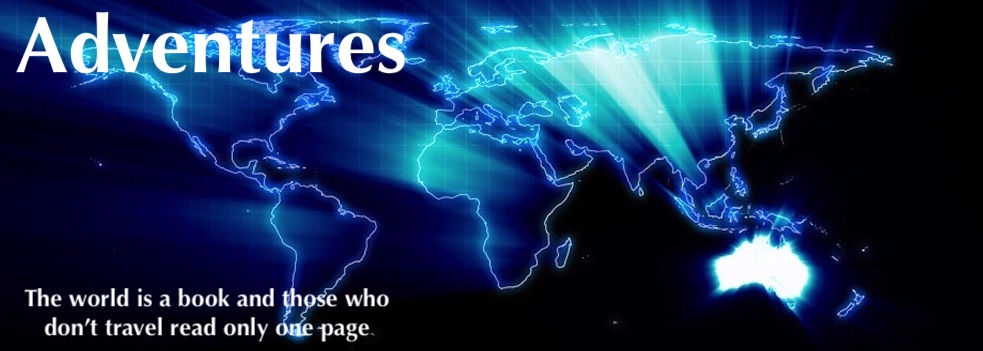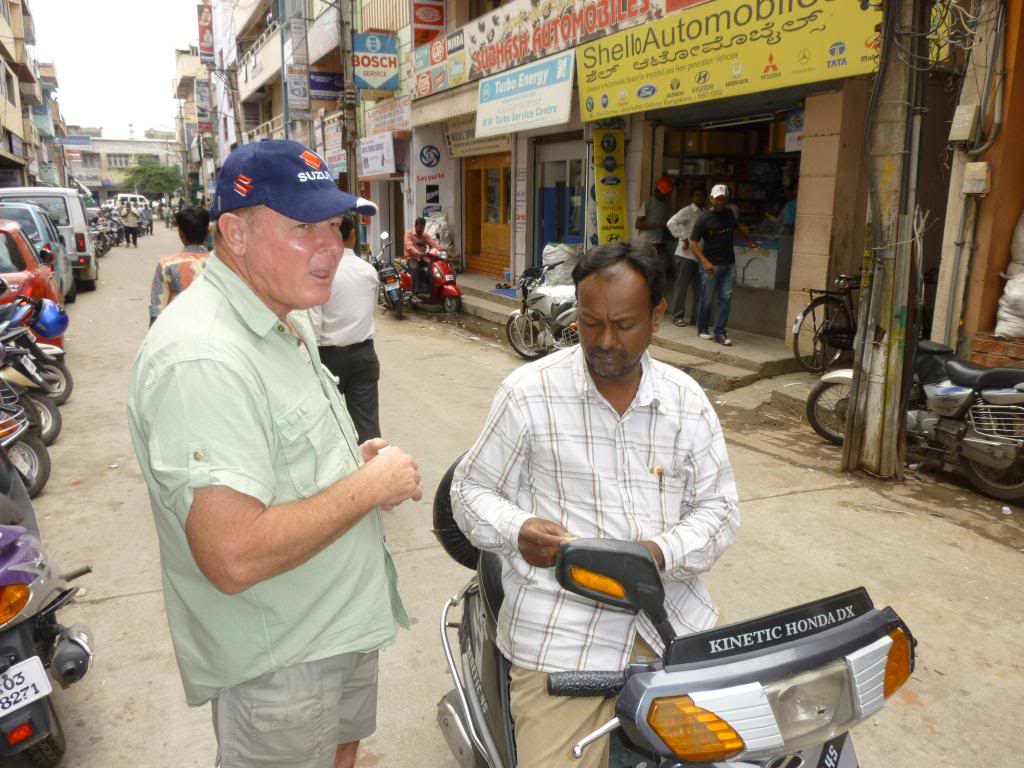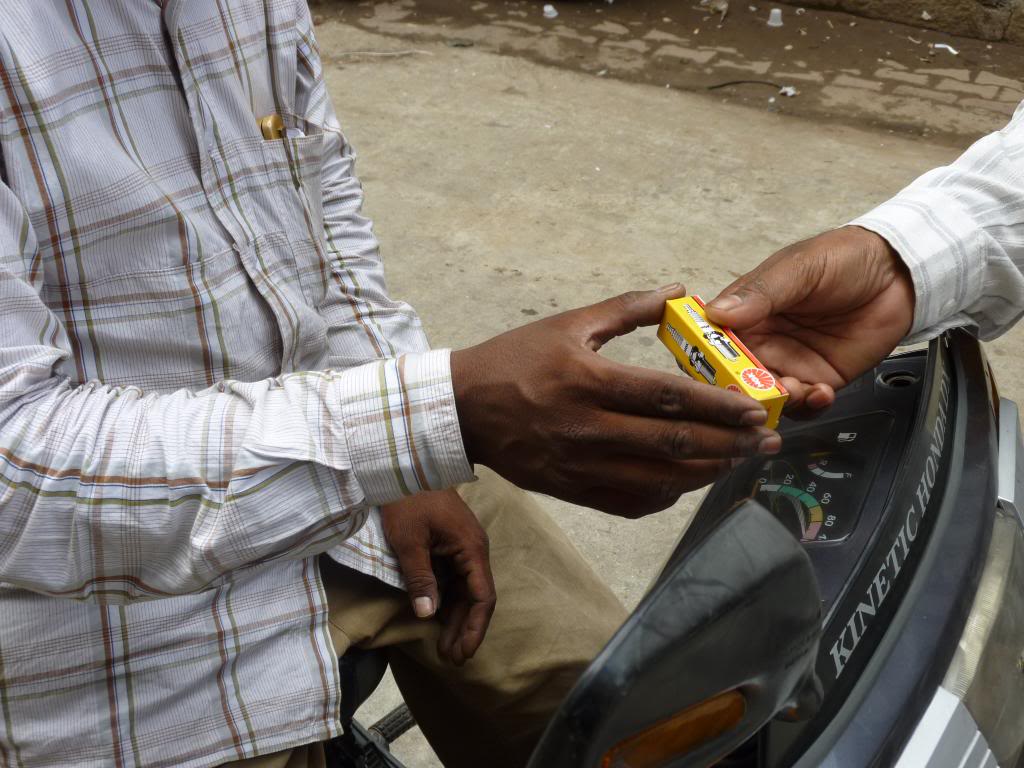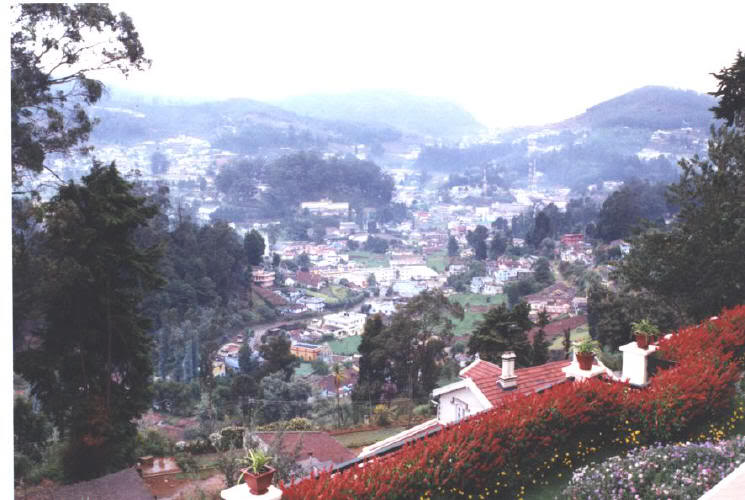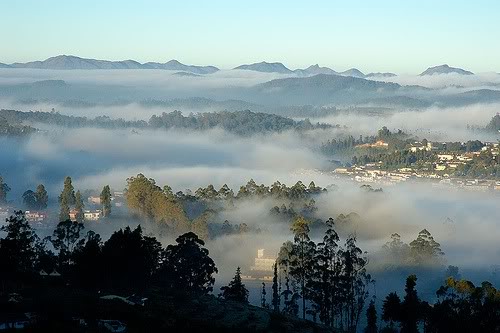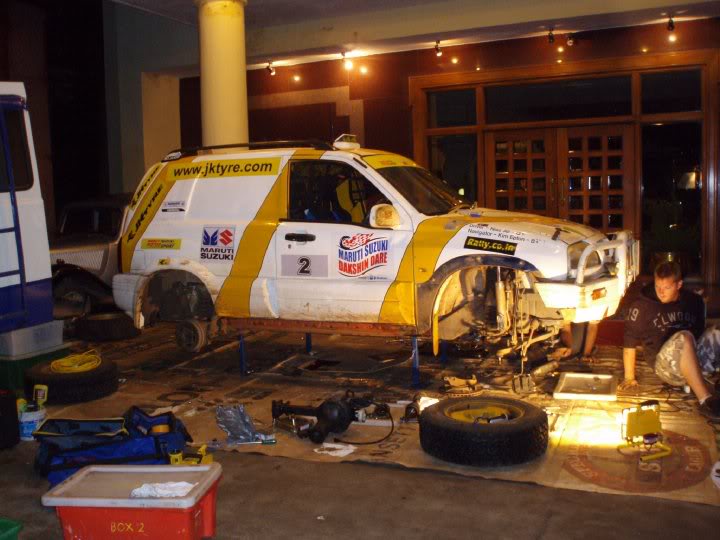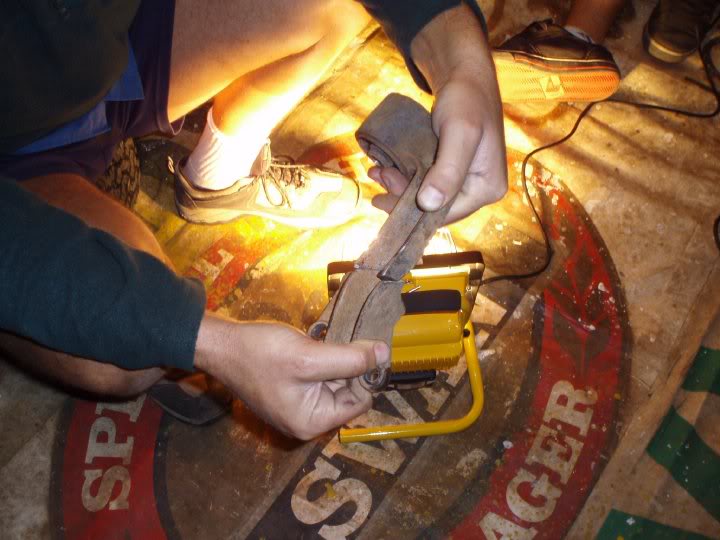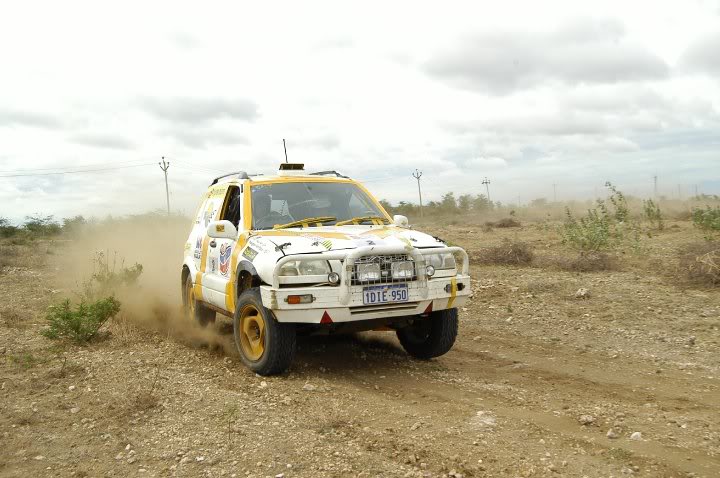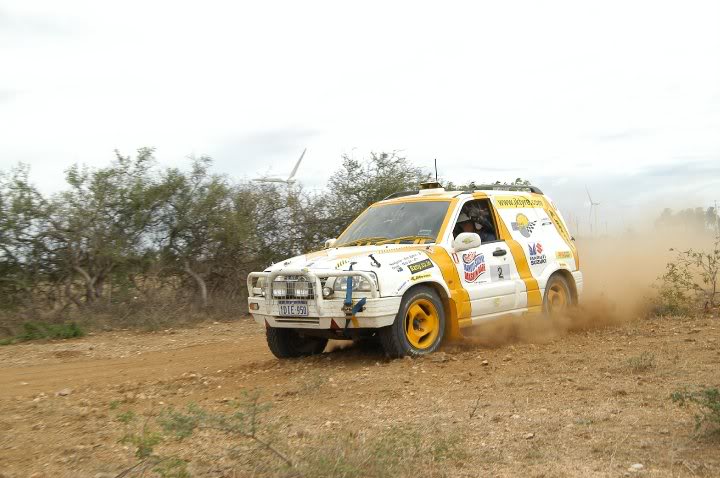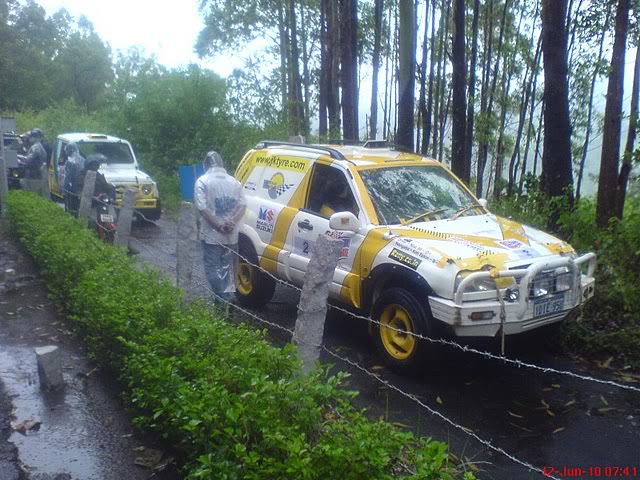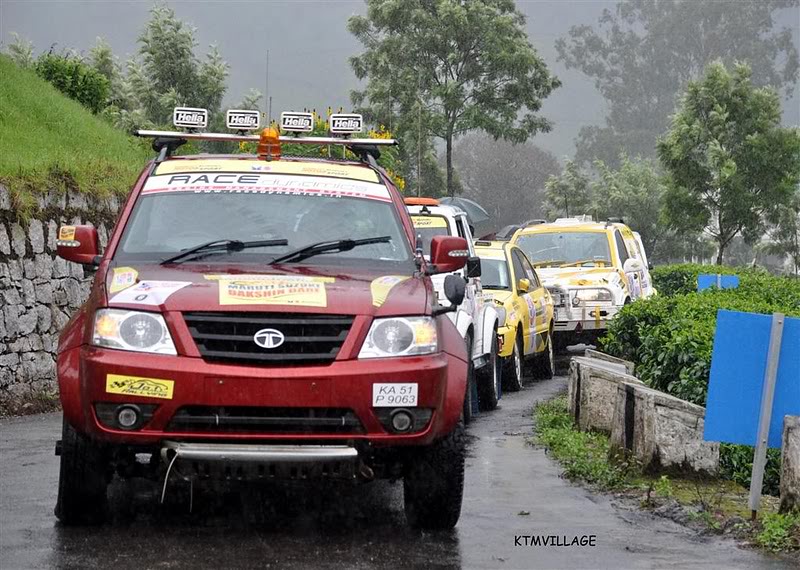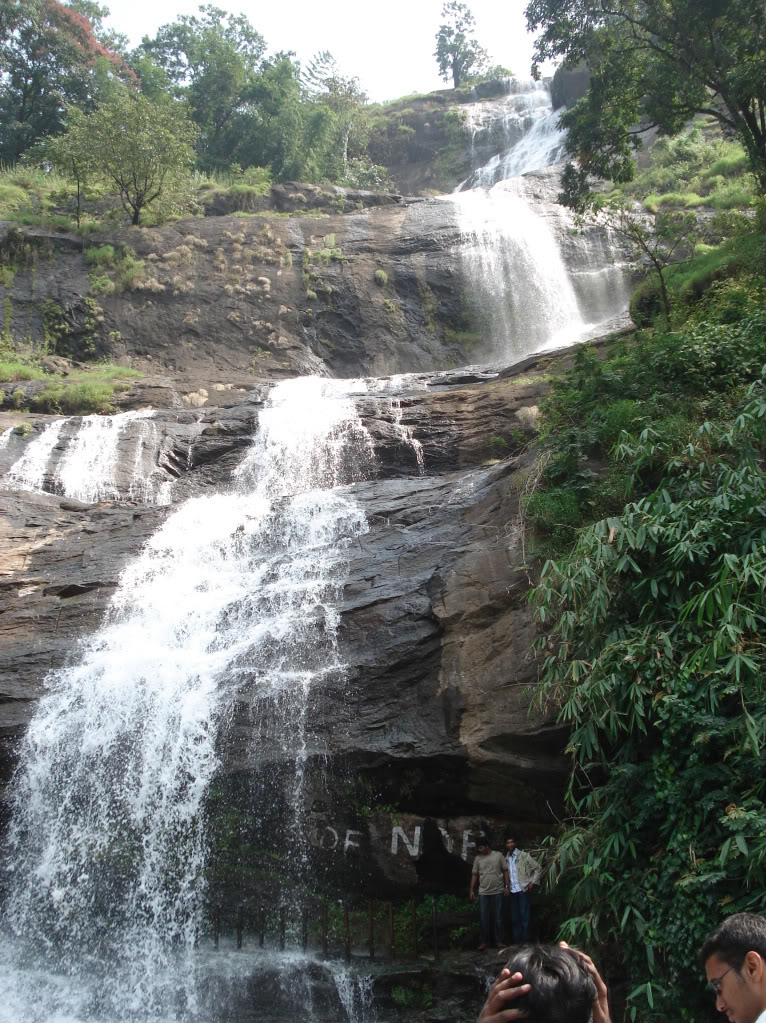As we prepare for the Dakshin Dare Cross Country Marathon in the Karnataka capital, Bangalore, in southern India, we realise that we don’t have spare spark plugs. Missing, lost or not packed, the result is the same – we need to get some spares before we head off on the five day Cross Country Marathon across south-west India.
So it’s off to the shops. The ‘motoring accessory precinct’ where there are uncountable ‘holes in the wall’ with stock stacked from floor to ceiling, five staff behind the counter and the inevitable crowd of onlookers observing our every move (as always in India there is a crowd watching every thing and any thing a foreigner does).
We are presented with brands and part numbers we don’t recognise. A phone call to Perth to our mechanic, Michael, who wasn’t able to make the trip, elicited the ‘conversions’.
We proffer part number, they counter attack with any old spark plug they have on the shelf, telling us “same, same”. We move from dingy shop to dark cave to another hole in the wall only to be told “no have, no have”.
- The motorparts precinct in Bangalore.
- Nitin Automobiles motorparts store in Bangalore.
- Searching for spark plugs at a ‘hole in the wall’ motorparts store.
Stepping over piles of rubbish, rubble and fresh, sacred cow excrement we move on from street to street before locating an emporium (about the size of a 20′ container) that has what we require. Just as we rejoice (because they also have a supply of octane boost – a vital necessity with India’s fuel) an employee on a motorbike from the shop we visited 20 minutes ago (the third one I think) tracks us down on the street. He produces two spark plugs.
- Kim bought spark plugs from the courier
- The treasured spark plug.
So, who to buy from? How the hell did the motorcyclist find us. I reward his initiative by taking the two spark plugs he has delivered. 110 rupees (about $2.75 for the two) And door to door service. Or, more correctly, ‘door to walking in the street service’.
But the more one comes to know this country, one realises that that sale might be what puts food on the table for his family that night.
The Dakshin Dare Cross Country (sort of) Marathon
The Dakshin Dare Cross Country Marathon started from the luxury Magrath Hotel in the centre of Bangalore and finished five days and 1800 kilometres later in Ernakulum near the seaside town of Cochin.
The event flagged off at 0430 from downtown Bangalore – a challenging time for most but not rallyists it seems.
The first thing we did was to get lost – along with everyone else who was not from Bangalore. So, follow the locals. The ‘tulips’ were wrong but eventually we found our way out of Bangalore (after going around one roundabout seven times looking for the correct exit (no exaggeration).
As is usual in India the Liaison (Transport) Stages often provide more excitement than the Competitive Stages. Through roadworks around 75 kilometres out of Bangalore we meet a bus travelling on the wrong side of the road (to avoid the dug up tarmac). It had to swerve violently to miss us (no headlights, of course). We smoked the tyres to prevent a head on. Early morning in India.
With that little adventure concluded we put the foot down to the Start of the first Competitive Stage and passed an Ambulance flying to an emergency with all lights blazing and sirens screaming (about 80kph). But nowhere near as fast as us! Only in India.
The first two scheduled stages of this Cross Country Marathon were on tarmac. We were issued with professionally produced, high quality Pace Notes. Foreign to an off roader. The flag dropped and the mayhem started. It was not a closed stage. Welcome to India.
Cars, motorbikes, tractors, herds of goats, cattle, villages, people (yes people!) were just some of the hazards to be negotiated at breakneck speeds. Absolute craziness. Accepted in India.
It was the first time using Pace Notes for me and I had no idea where we going. Occasionally I would pick up a call such as ‘Sharp Hairpin Left, Rough’ but most of the time I had to leave it to Niaz to drive as he saw it (he’s good at that!).
One hundred metres before the finish we hit a very sharp left turn. The Vitara was fully loaded going into the corner and as we rounded it we were presented with a nightmare – two guys on a motorbike who decided that they wanted our corner. We had nowhere to go (reducing India’s population of one billion by two was not an option) and Niaz swung right in the middle of the corner, just missing the rear end of the bike – but we ran off the road, clipped a building (school) and took out a wooden pole supporting the verandah roof. Into reverse, back onto the tarmac and on to the finish. Bloody India!
There were lots of strange noises coming from the right side of the car where it had done battle with concrete and timber. Out with the hammer to bash the bullbar away from the tyre and the rest of the noises would have to wait until Service.
Stage Two was cancelled after one of the cars hit a deer – one of an endangered species. Unacceptable in India.
Stage Three was another victim of officialdom (the deer episode escalated with the Police, and Wildlife Officers) and it too was cancelled. The raging torrent in the man-made canal just metres from the course was scary. Local competitors took great delight in telling stories of the various competitors who ended upside down in the water and had to smash windscreens and door glass to escape a watery death in previous events. Welcome to India.
On to Stage Four. We recorded the fastest time over this stage. It is as rough as anything to be encountered in a WA Offroad Event. We were airborne for 50 metres of one 100 metre section. Noted as ‘rough’. Mmmm?
The suspension held up well (thanks Daniel) but we inexplicably holed the exhaust on top. All cured in the Pit Area in the grounds of the Golden Landmark Resort at Mysore (look it up) – the finish of Day One. They know how to live it up in India.
- Repairs at Mysore.
We recorded the fastest time for the day by a margin of one minute and five seconds – and I’m sure I’ve reduced my life expectancy by a much greater margin. Incredible India.
What a crazy day. I had probably the scariest, most insane drive of my life on the last stage today – and it was a Transport (Liaison) Stage.
But earlier in the day we raced in private coffee plantations. Exhilarating racing. Very fast and tight turns, extremely narrow tracks, many acute and sharp turns and all at breakneck speeds. This is Stage Rallying not Cross Country Marathon – and quite a long way from offroad racing. But we still managed to do the same type of damage. We hit a tree head-on on one the acute right turns. Minor damage to an indicator.
As we came into what was to be the last stage of the day (the last two were cancelled) our fuel tank was leaking profusely. We told the Officials it was just overflow from the top up at Service but by the end of the stage it was clear that the tank was holed. We stopped at an Engineering Shop (think worst junkyard in Australia and that would be palatial by comparison). Out with the tank and the fuel was removed. The hole was welded (don’t ask – Worksafe would have gone into a funk! They would have closed down the site just from looking over the fence). Just over an hour later we were on our way again.
Would there be enough time to get to the hastily planned Regroup 160 kilometres up the road? It was a crazy, mad dash but a Sunday drive compared to the 2500m climb up the mountain into Ooty later.
On each of the stages earlier in the day we picked up time on our rivals and today we lead the Dakshin Dare by around five minutes.
The mountain climb into Ooty was an experience I will never forget. The Liaison Stage took us through a National Park where we saw elephants, wild buffalo and deer, and by the time we started the ascent it was dark. Indian drivers are notorious for driving anywhere on the road (mainly the wrong side) and driving without headlights illuminated at night (some believe that it wears out the globes, or uses too much power). The road switchbacks 2500m up the mountain. Fog closed in after about ten minutes. Overtaking slow vehicles on blind corners was initially terrifying but after the first few dozen oncoming trucks, buses and cars passed it became just mildly scary. Visibility was reduced to about a car length. We passed cars with only millimetres to spare. The mirror was clipped numerous times.
Finally we arrived in Ooty. At peak hour traffic time.
- Ooty
The tulip was wrong! And then it started to rain. By this time there was a convoy of three race cars and two bikes all sticking together. The navigator in the lead car, though not a local, had been to the town before and, by asking locals, was able to lead us to the Holiday Inn at the top of the mountain.
- Ooty in the clouds.
- Major underbody repairs on the front steps of the hotel at Ooty.
- Overnight repairs at Ooty.
As usual in India the Liaisons are just as exciting (and certainly more death defying) as the Competitive Stages.
The Start for Day Three was delayed and the rumour was that some tarmac stages had been cut which suited us as other cars had an advantage over us on tarmac.
Officialdom was whittling away the 1800 kilometre Cross Country Marathon. The second and third stages of Day Three of the Dakshin Dare were cancelled leaving only one stage.
But what a stage it was. This was one of the feature stages that had attracted the 70+ competitors – a hill climb with 63 hairpin bends.
The competing cars were lined up waiting for a start when the driver of the local bus decided he was not going to let a rally interfere with his two hour climb to the top of the mountain and proceeded blithely on his way past the queue and up the hill. If 63 hairpins wasn’t hazard enough all competitors now had to deal with a bus somewhere on the course. Anywhere else the stage would have been scrubbed but here it was treated as just another hazard. As it turned out, we caught the bus early into the stage and lost less than a minute getting around it.
Overnight the Service Crew worked on the vehicle at the front door of the hotel (the only place that provided light and shelter from the rain). The staff weren’t too happy with tools, parts, tyres and welding gear strewn around the main entrance. Our crew ignored them. When we emerged just before dawn the bike riders were lined up to have small jobs welded by our crew. The crew had changed the left front drive shaft and repaired bonnet catches, apart from a total tyre change and various other small repairs.
A third of the way into the stage our repaired bonnet catches broke. The secondary catch (another repair job), a ratchet strap, held for about three ks and then the bonnet flew up at 95 kph. Niaz hit the brakes and managed to bring the Vitara to a halt without slamming into the cliff face or running over the edge. We effected pretty good repairs to the catch and continued racing with a shattered windscreen, losing approximately two minutes.
Our lead had been reduced to about two minutes. There were more dirt stages planned for tomorrow (which obviously suited us) but there were still enough fast tarmac stages to allow Prithvy and Jeeva in their Cedia to catch us.
As usual the Transport from the end of stage through the towns to our city hotel gave one a new appreciation for the fragile gift of life.
We were fortunate to have a spare windscreen with us. On retrieving it from the roof of the Service Bus it was found to be cracked. Scrutineers examined it and declared it fit for use. There were a few rumblings over the next few days on various websites in India over the validity of the decision but the integrity of the screen was to remain intact to the end.
The bonnet catches were again repaired with Crew Chief, Paul Marriner, declaring, “If they break again I’ll walk home”.
Day Four of the Dakshin Dare started with a Transport Stage to a giant wind farm. The two dirt stages scheduled for the day were about six kilometres apart and are regularly used for the Indian National Rally Championship.
- The windfam was a great course.
- Racing at windfarm
The first stage was about 22 kilometres and the second about 41 kilometres. Both were twisting turning gravel/dirt/shale tracks in, around and under the giant wind turbines. A very different setting for a race course.
- The windfarm course was fast.
The first time through we were reasonably happy with our run, scoring the fastest time of the field. We had a good run on the second stage and during Liaison we heard a banging at the left front. The rim was nearly off. Only two wheels nuts were preventing complete disaster. We changed rims as the original was flogged out and stole a wheel nut from each of the other wheel hubs. In the process of changing the wheel we noticed that the spare wheels carrier was getting loose. Everything on the car was copping a hammering as we pushed to maintain and increase our lead.
We screamed into the village of Kethur and phoned our Service Crew (15 km away) to get them to come to our location asap. By sign language, and a mixture of Hindi and English we borrowed tools from the large crowd that had gathered where we parked in the middle of the main intersection (it’s ok, it’s India). The crowd got excited when I started attacking the rear door handle with a hammer. It had been jamming for two days.
Niaz was under the car removing the damaged sway bar. Through traffic was swerving around his protruding legs (it’s India). When the Service Crew arrived our local, sponsored mechanic was directed under the vehicle to replace two missing prop shaft bolts (the exhaust was hot – that made it his job). More temporary fixes were made to the bonnet. Paul inspected his handiwork from the previous night and contemplated a long walk. This time it was lashed loosely, in the hope that this would stop the various forms of restraints (bolts, pins, straps, rope, hooks, tape) from breaking.
The spare wheels carrier was removed along with one of the spares. The remaining wheel was strapped to the roll cage and finally we were ready to go.
We were two minutes late into Control and copped a penalty. Our road time over the five stages was five seconds faster than the nearest rival but the late time penalty precluded us from taking the daily trophy/prize.
The last Liaison (Transport) Stage took us through the Ernakulum National Park, Wildlife Park and Tiger Reserve. While we didn’t see any tigers it was a spectacular piece of routing by the Organisers. We climbed to 2600m, seeing tea plantations, waterfalls, monkeys, spectacular mountain scenery, switchbacks and, of course, crazy stupid Indian drivers who drive on the wrong side of the road, cut corners and overtake on blind bends.
The leg finished in Munnar, one of the highest towns in that part of India. Wet, too!
The Vitara was running beautifully. The engine gearbox and suspension were strong – it’s just that the peripherals and add ons were becoming add offs.
The last day of the Dakshin Dare was in the tea plantations around Munnar, at an elevation of 2600m. These stages were used for the London-Sydney Marathon.
The seventh instruction in the road book was in error and crews were tearing all over town looking for the correct route to the Control. We were 12 minutes late but so were most others. As the situation unfolded and concerns developed our tardiness became of little importance.
The monsoons were breaking. The wind and rain were intense. We were told there would be a delay while the course was cleared. As more and more vehicles appeared out on the course the agitation among the competitors increased. Eventually there was a mutiny. No one was prepared to start and eventually the stage was treated as a Transport. It was a pity because it would have suited us admirably.
- With the coming of the monsoon was an extended wait.
- The Stage became a Liaison.
The second stage was declared cleared and we took off for 22 kilometres of tight turns, switchbacks, culverts, dips, and gates all through tea plantations set in magnificent mountain scenery. Amid a monsoonal storm. Waterfalls cascaded down the sides of the mountains, seemingly created instantaneously. Giant jets of water sprayed onto the roads. Water with an intensity we had not seen before.
- Waterfall at Munnar.
- Instant waterfall at Munnar.
Hardly a section of road was straight for more than 60 metres. Spaced granite columns lined the downhill edge of the road and a rock wall was usually on the right side of the road. The pace was frenetic. We powered into a sharp left hander and all of a sudden we were going backwards. No discernible reason. No blowout, no loose surface, no oil, just an unfathomable spin. A further 90 degree change of direction and we came to halt between granite columns with our rear wheels hanging over the downslope – many hundreds of metres down. A 270 degree spinout. A quick check to see that everything was OK, foot flat and we were back onto the road and into the fray. The Flying Finish marker flashed past without further incident. We were advised that the stage was the last and the Dakshin Dare Cross Country Marathon was finished. We had won.
A successful end to months of planning and preparation.
© Kim Epton 2010-2024
3106 words, 17 photographs.
Feel free to use any part of this document but please do the right thing and give attribution to adventures.net.au. It will enhance the SEO of your website/blog and Adventures.
See Terms of Use.
